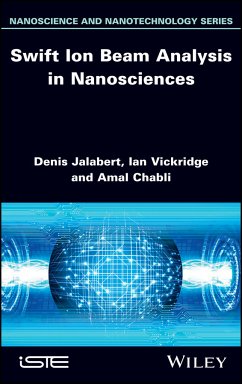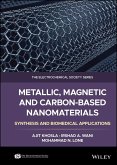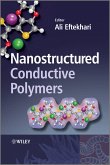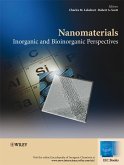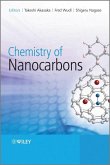139,99 €
139,99 €
inkl. MwSt.
Sofort per Download lieferbar

0 °P sammeln
139,99 €
Als Download kaufen

139,99 €
inkl. MwSt.
Sofort per Download lieferbar

0 °P sammeln
Jetzt verschenken
Alle Infos zum eBook verschenken
139,99 €
inkl. MwSt.
Sofort per Download lieferbar
Alle Infos zum eBook verschenken

0 °P sammeln
- Format: PDF
- Merkliste
- Auf die Merkliste
- Bewerten Bewerten
- Teilen
- Produkt teilen
- Produkterinnerung
- Produkterinnerung

Bitte loggen Sie sich zunächst in Ihr Kundenkonto ein oder registrieren Sie sich bei
bücher.de, um das eBook-Abo tolino select nutzen zu können.
Hier können Sie sich einloggen
Hier können Sie sich einloggen
Sie sind bereits eingeloggt. Klicken Sie auf 2. tolino select Abo, um fortzufahren.

Bitte loggen Sie sich zunächst in Ihr Kundenkonto ein oder registrieren Sie sich bei bücher.de, um das eBook-Abo tolino select nutzen zu können.
Swift ion beam analysis (IBA) of materials and their surfaces has been widely applied to many fields over the last half century, constantly evolving to meet new requirements and to take advantage of developments in particle detection and data treatment.
Today, emerging fields in nanosciences introduce extreme demands to analysis methods at the nanoscale. This book addresses how analysis with swift ion beams is rising to meet such needs. Aimed at early stage researchers and established researchers wishing to understand how IBA can contribute to their analytical requirements in nanosciences,…mehr
- Geräte: PC
- mit Kopierschutz
- eBook Hilfe
Andere Kunden interessierten sich auch für
![Two-Dimensional Nanomaterials for Biosensing and Imaging Applications (eBook, PDF) Two-Dimensional Nanomaterials for Biosensing and Imaging Applications (eBook, PDF)]() Two-Dimensional Nanomaterials for Biosensing and Imaging Applications (eBook, PDF)211,99 €
Two-Dimensional Nanomaterials for Biosensing and Imaging Applications (eBook, PDF)211,99 €![Metallic, Magnetic, and Carbon-Based Nanomaterials (eBook, PDF) Metallic, Magnetic, and Carbon-Based Nanomaterials (eBook, PDF)]() Ajit KhoslaMetallic, Magnetic, and Carbon-Based Nanomaterials (eBook, PDF)181,99 €
Ajit KhoslaMetallic, Magnetic, and Carbon-Based Nanomaterials (eBook, PDF)181,99 €![Nanostructured Conductive Polymers (eBook, PDF) Nanostructured Conductive Polymers (eBook, PDF)]() Nanostructured Conductive Polymers (eBook, PDF)204,99 €
Nanostructured Conductive Polymers (eBook, PDF)204,99 €![Infochemistry (eBook, PDF) Infochemistry (eBook, PDF)]() Konrad SzacilowskiInfochemistry (eBook, PDF)125,99 €
Konrad SzacilowskiInfochemistry (eBook, PDF)125,99 €![Nanomaterials (eBook, PDF) Nanomaterials (eBook, PDF)]() Nanomaterials (eBook, PDF)276,99 €
Nanomaterials (eBook, PDF)276,99 €![Chemistry of Nanocarbons (eBook, PDF) Chemistry of Nanocarbons (eBook, PDF)]() Chemistry of Nanocarbons (eBook, PDF)117,99 €
Chemistry of Nanocarbons (eBook, PDF)117,99 €![Nanoengineered Materials for Medical and Healthcare Applications (eBook, PDF) Nanoengineered Materials for Medical and Healthcare Applications (eBook, PDF)]() Nanoengineered Materials for Medical and Healthcare Applications (eBook, PDF)168,99 €
Nanoengineered Materials for Medical and Healthcare Applications (eBook, PDF)168,99 €-
-
-
Swift ion beam analysis (IBA) of materials and their surfaces has been widely applied to many fields over the last half century, constantly evolving to meet new requirements and to take advantage of developments in particle detection and data treatment.
Today, emerging fields in nanosciences introduce extreme demands to analysis methods at the nanoscale. This book addresses how analysis with swift ion beams is rising to meet such needs. Aimed at early stage researchers and established researchers wishing to understand how IBA can contribute to their analytical requirements in nanosciences, the basics of the interactions of charged particles with matter, as well as the operation of the relevant equipment, are first presented. Many recent examples from nanoscience research are then explored in which the specific analytical capabilities of IBA are emphasized, together with the place of IBA alongside the wealth of other analytical methods.
Today, emerging fields in nanosciences introduce extreme demands to analysis methods at the nanoscale. This book addresses how analysis with swift ion beams is rising to meet such needs. Aimed at early stage researchers and established researchers wishing to understand how IBA can contribute to their analytical requirements in nanosciences, the basics of the interactions of charged particles with matter, as well as the operation of the relevant equipment, are first presented. Many recent examples from nanoscience research are then explored in which the specific analytical capabilities of IBA are emphasized, together with the place of IBA alongside the wealth of other analytical methods.
Dieser Download kann aus rechtlichen Gründen nur mit Rechnungsadresse in D ausgeliefert werden.
Produktdetails
- Produktdetails
- Verlag: Capstone
- Erscheinungstermin: 14. August 2017
- Englisch
- ISBN-13: 9781119008736
- Artikelnr.: 52579381
- Verlag: Capstone
- Erscheinungstermin: 14. August 2017
- Englisch
- ISBN-13: 9781119008736
- Artikelnr.: 52579381
- Herstellerkennzeichnung Die Herstellerinformationen sind derzeit nicht verfügbar.
Denis Jalabert joined the institute of Nanosciences and Cryogenics at the CEA Grenoble in France 25 years ago. Since 1998, he has led the ion beam analysis activity of MINATEC/Grenoble and, more specifically, the Medium Energy Ion Scattering technique.
Ian Vickridge, CNRS Research Director in France, leads the SAFIR IBA platform of the Paris NanoSciences Institute, UPMC, Paris, France. Editor of Nuclear Instruments and Methods Section B since 2007, he has been involved in IBA for over 25 years.
Amal Chabli, CEA Research Director in France, is Senior Scientist at the Solar Technologies Department of the LITEN Institute, CEA, Grenoble, France. She has been involved in material characterization at the nanoscale in micro and nanotechnologies R&D for over 30 years.
Ian Vickridge, CNRS Research Director in France, leads the SAFIR IBA platform of the Paris NanoSciences Institute, UPMC, Paris, France. Editor of Nuclear Instruments and Methods Section B since 2007, he has been involved in IBA for over 25 years.
Amal Chabli, CEA Research Director in France, is Senior Scientist at the Solar Technologies Department of the LITEN Institute, CEA, Grenoble, France. She has been involved in material characterization at the nanoscale in micro and nanotechnologies R&D for over 30 years.
Preamble ix
Introduction xi
Chapter 1 Fundamentals of Ion-solid Interactions with a Focus on the
Nanoscale 1
1.1 General considerations 1
1.1.1 Wavelengths of ions, electrons and X-rays 1
1.1.2 Penetration depths of ions, electrons and X-rays 7
1.2 Basic physical concepts 8
1.2.1 Energy loss and range of ions in matter 8
1.2.2 Energy straggling 11
1.2.3 Elastic scattering 13
1.3 Channeling, shadowing and blocking 20
1.3.1 Channeling 20
1.3.2 Shadowing 23
1.3.3 Blocking 30
1.4 1D layers: limits to depth resolution 34
1.5 2D and 3D objects: aspects of lateral resolution 38
1.5.1 Beam focusing 38
1.5.2 Simulation of nanostructures 43
Chapter 2 Instruments and Methods 45
2.1 Instruments 45
2.1.1 Accelerators 45
2.1.2 Detectors and data acquisition 48
2.1.3 Analysis chambers 54
2.2 Methods 55
2.2.1 RBS and MEIS 56
2.2.2 ERDA 62
2.2.3 Narrow resonance profiling 64
Chapter 3 Applications 69
3.1 Example of resonances/light element profiling 69
3.1.1 Introduction 69
3.1.2 Channeling study of the SiO2/Si interface 70
3.1.3 Narrow resonance profiling and stable isotopic tracing studies of the
oxidation of silicon 73
3.1.4 Thermal oxidation of silicon carbide 76
3.1.5 Diffusion and reaction of CO in thermal SiO2: transport, exchange and
SiC nanocrystal growth 81
3.2 Quantitative analysis/heavy element profiling 86
3.2.1 RBS quantitative analysis of quantum dots and quantum wells 86
3.2.2 CMOS transistors and the race for miniaturization 114
3.3 Examples of HR-ERD analysis 131
3.3.1 Introduction 131
3.3.2 HRBS/HR-ERD comparison 132
3.3.3 HR-ERD profiles of Al2O3/TiO2 nanolaminates 133
3.4 Channeling/defect profiling 135
3.4.1 Introduction 135
3.4.2 Arsenic implant in ultra-shallow-junctions 135
3.5 Blocking/strain profiling 147
3.5.1 Introduction 147
3.5.2 GaN/AlN system 151
3.5.3 Si/Ge system 180
3.6 3D MEIS/real space structural analysis 195
3.6.1 Electrostatic analyzer method 196
3.6.2 Time-of-flight method 199
Chapter 4 The Place of NanoIBA in the Characterization Forest 203
4.1 Introduction 203
4.2 Scope of physical and chemical characterization 203
4.2.1 Targeted information by material characterization 204
4.2.2 Basic principle and instrumentation of material characterization 205
4.3 Ion-based characterization techniques overview 209
4.4 Ion-mass-spectroscopy-based characterization techniques versus IBA 211
4.4.1 Secondary ion mass spectrometry 211
4.4.2 Atom probe tomography 217
4.5 Other characterization techniques versus IBA 219
4.5.1 X-ray photoelectron spectroscopy 220
4.5.2 X-ray diffraction 222
4.5.3 X-ray absorption fine structure 223
4.5.4 Analytical electron microscopy 223
4.6 Emerging ion-beam-based techniques 225
4.6.1 Low energy ion scattering 226
4.6.2 Iono-luminescence 226
4.6.3 Scanning helium ion microscopy 226
4.6.4 Grazing incidence fast atoms diffraction 228
List of Acronyms 231
Bibliography 237
Index 257
Introduction xi
Chapter 1 Fundamentals of Ion-solid Interactions with a Focus on the
Nanoscale 1
1.1 General considerations 1
1.1.1 Wavelengths of ions, electrons and X-rays 1
1.1.2 Penetration depths of ions, electrons and X-rays 7
1.2 Basic physical concepts 8
1.2.1 Energy loss and range of ions in matter 8
1.2.2 Energy straggling 11
1.2.3 Elastic scattering 13
1.3 Channeling, shadowing and blocking 20
1.3.1 Channeling 20
1.3.2 Shadowing 23
1.3.3 Blocking 30
1.4 1D layers: limits to depth resolution 34
1.5 2D and 3D objects: aspects of lateral resolution 38
1.5.1 Beam focusing 38
1.5.2 Simulation of nanostructures 43
Chapter 2 Instruments and Methods 45
2.1 Instruments 45
2.1.1 Accelerators 45
2.1.2 Detectors and data acquisition 48
2.1.3 Analysis chambers 54
2.2 Methods 55
2.2.1 RBS and MEIS 56
2.2.2 ERDA 62
2.2.3 Narrow resonance profiling 64
Chapter 3 Applications 69
3.1 Example of resonances/light element profiling 69
3.1.1 Introduction 69
3.1.2 Channeling study of the SiO2/Si interface 70
3.1.3 Narrow resonance profiling and stable isotopic tracing studies of the
oxidation of silicon 73
3.1.4 Thermal oxidation of silicon carbide 76
3.1.5 Diffusion and reaction of CO in thermal SiO2: transport, exchange and
SiC nanocrystal growth 81
3.2 Quantitative analysis/heavy element profiling 86
3.2.1 RBS quantitative analysis of quantum dots and quantum wells 86
3.2.2 CMOS transistors and the race for miniaturization 114
3.3 Examples of HR-ERD analysis 131
3.3.1 Introduction 131
3.3.2 HRBS/HR-ERD comparison 132
3.3.3 HR-ERD profiles of Al2O3/TiO2 nanolaminates 133
3.4 Channeling/defect profiling 135
3.4.1 Introduction 135
3.4.2 Arsenic implant in ultra-shallow-junctions 135
3.5 Blocking/strain profiling 147
3.5.1 Introduction 147
3.5.2 GaN/AlN system 151
3.5.3 Si/Ge system 180
3.6 3D MEIS/real space structural analysis 195
3.6.1 Electrostatic analyzer method 196
3.6.2 Time-of-flight method 199
Chapter 4 The Place of NanoIBA in the Characterization Forest 203
4.1 Introduction 203
4.2 Scope of physical and chemical characterization 203
4.2.1 Targeted information by material characterization 204
4.2.2 Basic principle and instrumentation of material characterization 205
4.3 Ion-based characterization techniques overview 209
4.4 Ion-mass-spectroscopy-based characterization techniques versus IBA 211
4.4.1 Secondary ion mass spectrometry 211
4.4.2 Atom probe tomography 217
4.5 Other characterization techniques versus IBA 219
4.5.1 X-ray photoelectron spectroscopy 220
4.5.2 X-ray diffraction 222
4.5.3 X-ray absorption fine structure 223
4.5.4 Analytical electron microscopy 223
4.6 Emerging ion-beam-based techniques 225
4.6.1 Low energy ion scattering 226
4.6.2 Iono-luminescence 226
4.6.3 Scanning helium ion microscopy 226
4.6.4 Grazing incidence fast atoms diffraction 228
List of Acronyms 231
Bibliography 237
Index 257
Preamble ix
Introduction xi
Chapter 1 Fundamentals of Ion-solid Interactions with a Focus on the
Nanoscale 1
1.1 General considerations 1
1.1.1 Wavelengths of ions, electrons and X-rays 1
1.1.2 Penetration depths of ions, electrons and X-rays 7
1.2 Basic physical concepts 8
1.2.1 Energy loss and range of ions in matter 8
1.2.2 Energy straggling 11
1.2.3 Elastic scattering 13
1.3 Channeling, shadowing and blocking 20
1.3.1 Channeling 20
1.3.2 Shadowing 23
1.3.3 Blocking 30
1.4 1D layers: limits to depth resolution 34
1.5 2D and 3D objects: aspects of lateral resolution 38
1.5.1 Beam focusing 38
1.5.2 Simulation of nanostructures 43
Chapter 2 Instruments and Methods 45
2.1 Instruments 45
2.1.1 Accelerators 45
2.1.2 Detectors and data acquisition 48
2.1.3 Analysis chambers 54
2.2 Methods 55
2.2.1 RBS and MEIS 56
2.2.2 ERDA 62
2.2.3 Narrow resonance profiling 64
Chapter 3 Applications 69
3.1 Example of resonances/light element profiling 69
3.1.1 Introduction 69
3.1.2 Channeling study of the SiO2/Si interface 70
3.1.3 Narrow resonance profiling and stable isotopic tracing studies of the
oxidation of silicon 73
3.1.4 Thermal oxidation of silicon carbide 76
3.1.5 Diffusion and reaction of CO in thermal SiO2: transport, exchange and
SiC nanocrystal growth 81
3.2 Quantitative analysis/heavy element profiling 86
3.2.1 RBS quantitative analysis of quantum dots and quantum wells 86
3.2.2 CMOS transistors and the race for miniaturization 114
3.3 Examples of HR-ERD analysis 131
3.3.1 Introduction 131
3.3.2 HRBS/HR-ERD comparison 132
3.3.3 HR-ERD profiles of Al2O3/TiO2 nanolaminates 133
3.4 Channeling/defect profiling 135
3.4.1 Introduction 135
3.4.2 Arsenic implant in ultra-shallow-junctions 135
3.5 Blocking/strain profiling 147
3.5.1 Introduction 147
3.5.2 GaN/AlN system 151
3.5.3 Si/Ge system 180
3.6 3D MEIS/real space structural analysis 195
3.6.1 Electrostatic analyzer method 196
3.6.2 Time-of-flight method 199
Chapter 4 The Place of NanoIBA in the Characterization Forest 203
4.1 Introduction 203
4.2 Scope of physical and chemical characterization 203
4.2.1 Targeted information by material characterization 204
4.2.2 Basic principle and instrumentation of material characterization 205
4.3 Ion-based characterization techniques overview 209
4.4 Ion-mass-spectroscopy-based characterization techniques versus IBA 211
4.4.1 Secondary ion mass spectrometry 211
4.4.2 Atom probe tomography 217
4.5 Other characterization techniques versus IBA 219
4.5.1 X-ray photoelectron spectroscopy 220
4.5.2 X-ray diffraction 222
4.5.3 X-ray absorption fine structure 223
4.5.4 Analytical electron microscopy 223
4.6 Emerging ion-beam-based techniques 225
4.6.1 Low energy ion scattering 226
4.6.2 Iono-luminescence 226
4.6.3 Scanning helium ion microscopy 226
4.6.4 Grazing incidence fast atoms diffraction 228
List of Acronyms 231
Bibliography 237
Index 257
Introduction xi
Chapter 1 Fundamentals of Ion-solid Interactions with a Focus on the
Nanoscale 1
1.1 General considerations 1
1.1.1 Wavelengths of ions, electrons and X-rays 1
1.1.2 Penetration depths of ions, electrons and X-rays 7
1.2 Basic physical concepts 8
1.2.1 Energy loss and range of ions in matter 8
1.2.2 Energy straggling 11
1.2.3 Elastic scattering 13
1.3 Channeling, shadowing and blocking 20
1.3.1 Channeling 20
1.3.2 Shadowing 23
1.3.3 Blocking 30
1.4 1D layers: limits to depth resolution 34
1.5 2D and 3D objects: aspects of lateral resolution 38
1.5.1 Beam focusing 38
1.5.2 Simulation of nanostructures 43
Chapter 2 Instruments and Methods 45
2.1 Instruments 45
2.1.1 Accelerators 45
2.1.2 Detectors and data acquisition 48
2.1.3 Analysis chambers 54
2.2 Methods 55
2.2.1 RBS and MEIS 56
2.2.2 ERDA 62
2.2.3 Narrow resonance profiling 64
Chapter 3 Applications 69
3.1 Example of resonances/light element profiling 69
3.1.1 Introduction 69
3.1.2 Channeling study of the SiO2/Si interface 70
3.1.3 Narrow resonance profiling and stable isotopic tracing studies of the
oxidation of silicon 73
3.1.4 Thermal oxidation of silicon carbide 76
3.1.5 Diffusion and reaction of CO in thermal SiO2: transport, exchange and
SiC nanocrystal growth 81
3.2 Quantitative analysis/heavy element profiling 86
3.2.1 RBS quantitative analysis of quantum dots and quantum wells 86
3.2.2 CMOS transistors and the race for miniaturization 114
3.3 Examples of HR-ERD analysis 131
3.3.1 Introduction 131
3.3.2 HRBS/HR-ERD comparison 132
3.3.3 HR-ERD profiles of Al2O3/TiO2 nanolaminates 133
3.4 Channeling/defect profiling 135
3.4.1 Introduction 135
3.4.2 Arsenic implant in ultra-shallow-junctions 135
3.5 Blocking/strain profiling 147
3.5.1 Introduction 147
3.5.2 GaN/AlN system 151
3.5.3 Si/Ge system 180
3.6 3D MEIS/real space structural analysis 195
3.6.1 Electrostatic analyzer method 196
3.6.2 Time-of-flight method 199
Chapter 4 The Place of NanoIBA in the Characterization Forest 203
4.1 Introduction 203
4.2 Scope of physical and chemical characterization 203
4.2.1 Targeted information by material characterization 204
4.2.2 Basic principle and instrumentation of material characterization 205
4.3 Ion-based characterization techniques overview 209
4.4 Ion-mass-spectroscopy-based characterization techniques versus IBA 211
4.4.1 Secondary ion mass spectrometry 211
4.4.2 Atom probe tomography 217
4.5 Other characterization techniques versus IBA 219
4.5.1 X-ray photoelectron spectroscopy 220
4.5.2 X-ray diffraction 222
4.5.3 X-ray absorption fine structure 223
4.5.4 Analytical electron microscopy 223
4.6 Emerging ion-beam-based techniques 225
4.6.1 Low energy ion scattering 226
4.6.2 Iono-luminescence 226
4.6.3 Scanning helium ion microscopy 226
4.6.4 Grazing incidence fast atoms diffraction 228
List of Acronyms 231
Bibliography 237
Index 257
